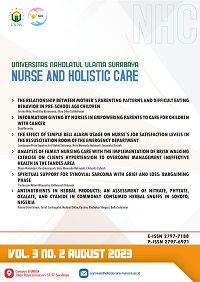THE EFFECT OF SIMPLE BELL ALARM USAGE ON NURSE’S JOB SATISFACTION LEVELS IN THE RESUSCITATION ROOM OF THE EMERGENCY DEPARTMENT
##plugins.themes.bootstrap3.article.main##
Abstract
Background: The Emergency Room (ER) of ER of Haji Surabaya General Regional Hospital consists of many partitions, but there is no code blue activation. The ER staff use the methods by phone calling or shouting, if they need a request for assistance in handling resuscitation patients. The team has the potential to feel dissatisfied with the infrastructure at work.
Objective: The purposes of this research is to analyse the effect of using a simple alarm bell on the job satisfaction of nurses in the emergency room resuscitation.
Methods: The research design used the Pre-Experimental method (One Group Pretest-Posttest). The population in this study were all nurses in the emergency room at the ER of Haji Surabaya General Regional Hospital in Surabaya, totaling 34 nurses. Using the total sampling technique, a sample of 31 nurses was obtained. The independent variable is the simple use of the alarm bell, and the dependent variable is the level of nurse satisfaction. Data collection tool using a job satisfaction level questionnaire. Data analysis using the Wilcoxon test.
Result: The results of data analysis using the Wilcoxon sign rank test yielded a value of p = 0.051 (0.051> 0.05) then H0 was rejected, which means that there was no significant difference between the level of job satisfaction of nurses before and after using a simple alarm bell. However, the results of the analysis of the average level of satisfaction before and after using the simple bell alarm were 24.52 and 25.35 points. In the total number of assessments, it was found that the average level of satisfaction after using the simple bell alarm was greater than the average level of satisfaction before using the simple bell alarm, there was a difference of 0.83 points.
Conclusion: The results of this study can be concluded that Job satisfaction of all nurses in the emergency resuscitation room before using the simple bell alarm was satisfied. Job satisfaction of all nurses in the emergency resuscitation room after using the simple bell alarm was satisfied. There is no significant difference between the level of job satisfaction before and after using the simple alarm bell, but there is an increase in nurse satisfaction points descriptively with the infrastructure that supports their work. The use of a simple alarm bell in this study should be evaluated periodically by the nursing department in the hospital in order to determine its effectiveness in patient care.
Downloads
##plugins.themes.bootstrap3.article.details##
Copyright (c) 2023 Sundawam Priyo Seputra, Arif Helmi Setiawan, Nety Mawarda Hatmanti, Imamatul Faizah

This work is licensed under a Creative Commons Attribution-NonCommercial 4.0 International License.
Authors who publish with Nurse and Holistic Care agree to the following terms:
- Authors retain copyright licensed under a Creative Commons Attribution-NonCommercial 4.0 (CC BY-NC 4.0), which allows others to remix, tweak, and build upon the authors' work non-commercially, and although the others' new works must also acknowledge the authors and be non-commercial, they don't have to license their derivative works on the same terms.
- Authors are permitted and encouraged to post their work online (e.g., in institutional repositories or on their website) prior to and during the submission process, as it can lead to productive exchanges, as well as earlier and greater citation of published work (See The Effect of Open Access). Authors can archive pre-print and post-print or publisher's version/PDF.
References
Ardlianawati, N., Rochman, T., Kunaifi, A., & Pratama, E. R. (2022). Reducing Patients' Death Rate Through Rapid Response Team Bell Activation in Emergency Room. Journal of Nursing Science Update, 10(1), 2829–2832. https://doi.org/10.21776/ub.jik.2022.010.01.8.
Chen, J., Ou, L., Hillman, K., Flabouris, A., Bellomo, R., Hollis, S. J., & Assareh, H. (2014). The impact of implementing a rapid response system: A comparison of cardiopulmonary arrests and mortality among four teaching hospitals in Australia. Resuscitation, 85(9), 1275–1281. https://doi.org/10.1016/j.resuscitation.2014.06.003. DOI: https://doi.org/10.1016/j.resuscitation.2014.06.003
Gatot, D. B., & Adisasmito, W. (2005). The Relationship between Nurse Characteristics, Job Content and Work Environment on Nurse Job Satisfaction at the Gunung Jati Hospital Inpatient Installation, Cirebon Makara Health University of Indonesia, 9(1), 1–8.
Juliati, N. M. W., Duarsa, D. P., & Yuliyatni, P. C. D. (2021). Correlation between Characteristics, Job Satisfaction, Motivation of Nurses and Doctors with Commitment to Achieving Minimum Service Standards in the Emergency Room at the Regional General Hospital in Badung Mangusada Regency. Udayana Medical Journal, 10(9),1–6. https://ojs.unud.ac.id/index.php/eum/article/view/69570. DOI: https://doi.org/10.24843/MU.2021.V10.i9.P01
Government Regulation of the Republic of Indonesia number 24 of 2018 concerning Emergency Services, Number 24 Minister of Health of the Republic of Indonesia Regulation of the Minister of Health of the Republic of Indonesia 6 (2018).
Kusumawati, D., & Frandinata, D. (2015). The Relationship between Workload and Nurse Performance in the Blambangan Hospital Igd Room, Banyuwangi, 2015. Rustida Scientific Journal of Health, 3 (Nurse Performance), 176–190.
Minister of Health. (2009). Decree of the Minister of Health of the Republic of Indonesia Number 856 / Menkes / Sk / Ix / 2009 concerning Hospital Emergency Installation (IGD) Standards.
Roflin, E. (2022). Health Research Methods. NEM Publisher. https://books.google.co.id/books?id=6P9fEAAAQBAJ.
Suroso, J. (2011). Structuring a competency-based career path system to increase job satisfaction and performance of nurses in hospitals. Explanation, 6 (September), 123–131. https://citeseerx.ist.psu.edu/document?repid=rep1&type=pdf&doi=89cc4eb0718037bcb12363b010116e2d9d9d5eef.
MPKP Team, M. P. K. JIWA. J. (2016). Professional Nursing Practice Model Module (MPKP). MPPKP Team, 1(2),1–14. https://journal.stieamkop.ac.id/index.php/mirai/article/view/33.
Welch, S. J., Cheung, D. S., Apker, J., & Patterson, E. S. (2013). Strategies for improving communication in the emergency department: Mediums and messages in a noisy environment. Joint Commission Journal on Quality and Patient Safety, 39(6), 279–286. https://doi.org/10.1016/S1553-7250(13)39039-4. DOI: https://doi.org/10.1016/S1553-7250(13)39039-4
Wijaya, I. W. S., Mutiarahati, N. L. A. C., Rosita, N. P. I., & Wira, I. Ayu D. (2023). Competence in Improving Nurse Job Satisfaction: Literature Review. Scientific Development Media,4(1),88–100. http://binapatria.id/index.php/MBI/article/view/341.

